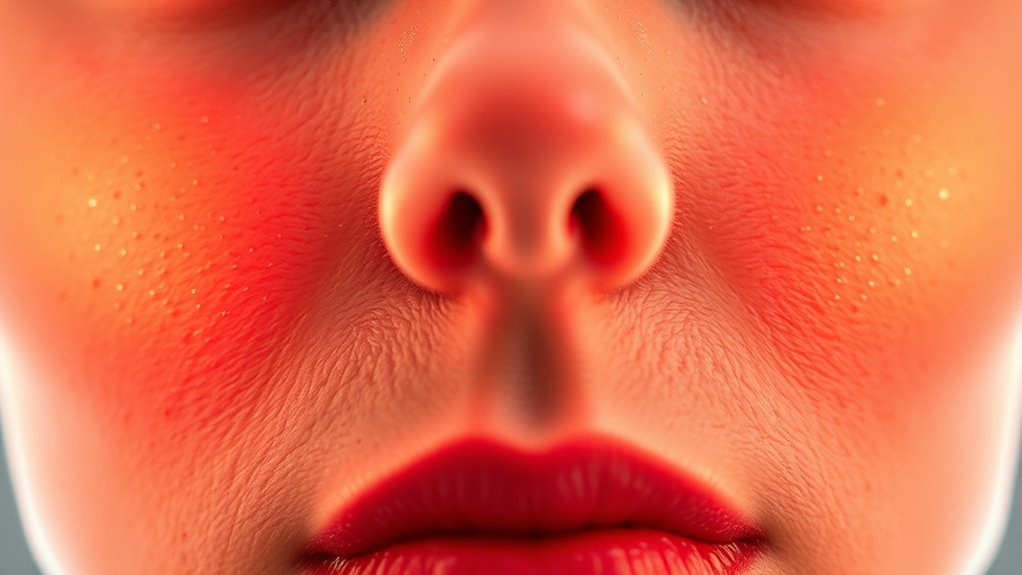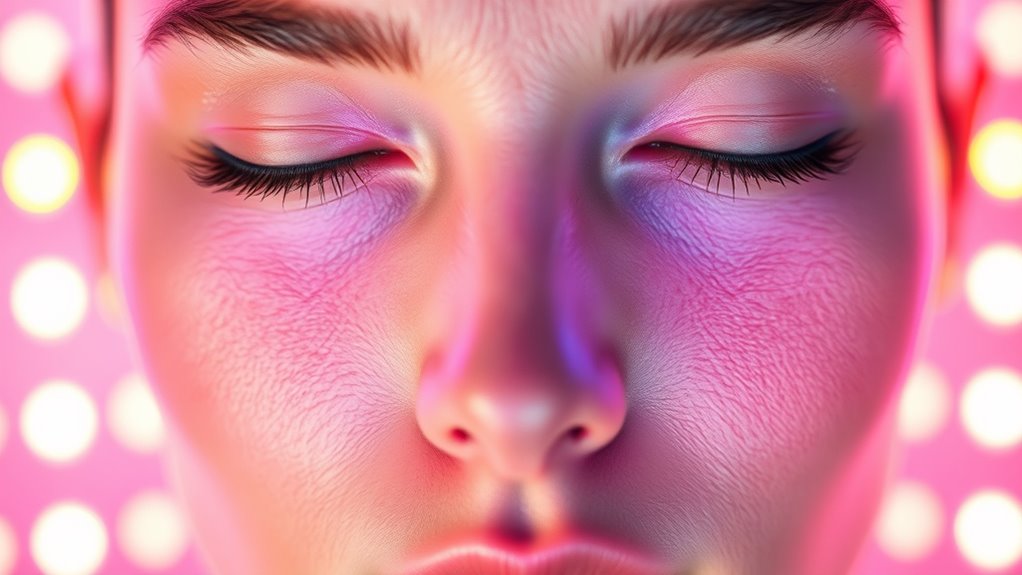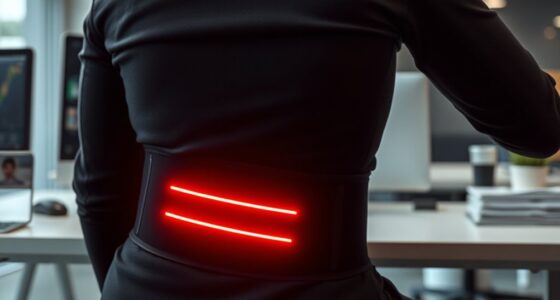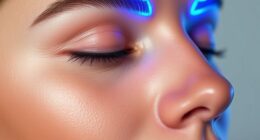Light therapy can temporarily improve how your pores look by reducing inflammation, excess oil, and redness. However, it doesn’t physically shrink or change their size over the long term because pore size is mainly determined by genetics. The visible results are mostly surface-level and fade without ongoing care. If you want to learn how to manage your pores effectively and understand what to expect, you’ll find helpful tips if you keep exploring.
Key Takeaways
- Light therapy temporarily improves skin texture and reduces inflammation, making pores appear smaller immediately after treatment.
- It does not physically alter pore size, as pore dimensions are determined by genetics and skin structure.
- Visible results from light therapy are short-term and fade without ongoing skincare routines.
- Combining light therapy with proper skincare enhances overall pore appearance but doesn’t change their fundamental size.
- Long-term pore management relies on consistent skincare, sun protection, and realistic expectations about treatment effects.

Light therapy has gained popularity as a non-invasive treatment for various skin concerns, including the appearance of pores. You might have seen advertisements claiming it can reduce pore size or make your skin look smoother and more refined. While it’s true that many people find light therapy helpful for improving overall skin texture, it’s important to understand what it can and can’t do regarding pore appearance. Often, the results you see are more about how your skin looks immediately after treatment rather than permanent changes to pore size. Pores are an inherent part of your skin’s structure, and their size is largely determined by genetics. No skincare treatment can drastically change the physical size of your pores, but some therapies can influence the appearance temporarily.
Light therapy improves skin texture temporarily but doesn’t permanently reduce pore size.
When you undergo light therapy, such as LED treatments, the light penetrates your skin at different wavelengths, targeting issues like inflammation, bacteria, and excess oil. This process can help clear out your pores and reduce the buildup that makes them look more prominent. For example, blue light is effective against acne-causing bacteria, which can lead to fewer breakouts and less pore clogging. Red light, on the other hand, promotes healing and might improve skin elasticity over time. These benefits can give your skin a smoother, more uniform appearance, making your pores less noticeable. However, keep in mind that the visible improvement is often related to the temporary reduction of inflammation and oil, not a permanent shrinking of the pores themselves.
You might notice that right after a session, your skin looks clearer and more refined. This is partly because light therapy reduces swelling, tightens the skin temporarily, and diminishes redness. But these effects often fade within days or weeks if you don’t maintain a consistent skincare routine. To truly manage pore appearance, you should combine light therapy with other practices like regular cleansing, exfoliation, and moisturizing. These steps help keep your pores clean and prevent them from becoming enlarged due to congestion or excess oil.
Additionally, understanding the role of skin elasticity can help set realistic expectations for treatment outcomes. In reality, light therapy offers a visible improvement in skin clarity and texture, which can make your pores less obvious temporarily. But it doesn’t fundamentally alter their size or remove them completely. If you’re looking for long-term results, managing expectations is key. The best approach involves a holistic skincare routine, sun protection, and consistent treatments. Light therapy is a useful tool in that arsenal, but it’s not a magic bullet for pore size reduction. Understanding the difference between appearance and reality helps you make informed decisions about your skincare journey.
Frequently Asked Questions
Can Light Therapy Permanently Close Enlarged Pores?
Light therapy can’t permanently close enlarged pores. It can reduce their appearance temporarily by stimulating collagen and tightening the skin, but the pores themselves don’t actually shrink or close permanently. If you want long-lasting results, consider combining light therapy with other treatments like chemical peels or microdermabrasion. Maintain a good skincare routine, stay consistent, and manage oil production to prevent pores from enlarging again over time.
Does Light Therapy Cause Skin Damage or Irritation?
Light therapy typically doesn’t cause skin damage or irritation when used properly. You might experience mild redness, swelling, or sensitivity afterward, but these effects usually fade quickly. To avoid issues, follow your provider’s instructions and start with shorter sessions. If you notice persistent discomfort, stop treatment and consult a dermatologist. Overall, light therapy is generally safe, but proper use is key to preventing any adverse reactions.
How Long Do Results From Light Therapy Last?
Your results from light therapy can last anywhere from a few weeks to several months, depending on your skin type, the condition treated, and your skincare routine. To maintain benefits, you might need periodic touch-up sessions. Consistently protecting your skin from sun exposure and following your dermatologist’s advice helps prolong the results. Keep in mind, individual responses vary, so staying committed to your skincare regimen is key to lasting improvements.
Is Light Therapy Effective on All Skin Types?
You might be surprised, but light therapy can be effective on all skin types. Coincidentally, it’s versatile enough to target a variety of concerns, from acne to signs of aging. You should keep in mind, however, that results can differ based on skin tone and condition. Consulting with a dermatologist helps ensure you choose the right treatment plan for your skin’s unique needs, maximizing effectiveness.
What Are the Costs Associated With Professional Light Therapy Treatments?
You can expect professional light therapy treatments to cost between $50 and $150 per session, depending on your location, provider, and treatment type. Some clinics offer package deals that can lower the overall cost. Keep in mind, multiple sessions are usually necessary for noticeable results. Insurance typically doesn’t cover these treatments, so it’s essential to budget accordingly and discuss costs upfront with your dermatologist or skincare specialist.
Conclusion
So, while light therapy might promise to shrink your pores like magic, don’t forget it’s not a miracle wand. It can improve skin texture and clarity, but pores are like the stars—never truly disappear, only seem smaller. Think of it as turning down the volume rather than shutting off the noise. Keep realistic expectations, and remember, glowing skin comes from consistency and a good skincare routine, not just a flick of the light.









